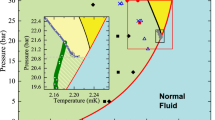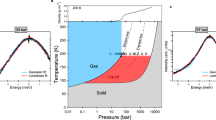Abstract
THE rotating helium cryostat (1-m diameter, 3,000 r.p.m.) at Southampton provides a novel way of studying the behaviour of liquid helium. The centrifugal acceleration fields (up to 5,000g at the periphery) enable pressure differences up to 20 bar to be generated in radial ducts containing liquid helium between the axis and the periphery of the rotor. We have recently rotated the cryostat at temperatures down to 1.8 K, well below the λ-transition to superfluid helium. The λ-transition temperature is suppressed by increasing pressure so that the rotor becomes a unique tool for the study of the phase transition boundary between normal helium He(I) and superfluid helium He(II). Here we report observations of a step-like temperature difference of several tens of millikelvin across the boundary. The temperature jump can be explained in terms of the positive value of the volume coefficient of expansion for He(I) over a finite temperature interval above the λ-line, and the presence of a non-convecting intermediate state of finite thickness separating the two phases.
This is a preview of subscription content, access via your institution
Access options
Subscribe to this journal
Receive 51 print issues and online access
$199.00 per year
only $3.90 per issue
Buy this article
- Purchase on Springer Link
- Instant access to full article PDF
Prices may be subject to local taxes which are calculated during checkout
Similar content being viewed by others
References
Haseler, L. E., Scurlock, R. G. & Thornton, G. K. Cryogenics 16, 331–336 (1976).
Haseler, L. E., Scurlock, R. G. & Utton, D. B. Cryogenics 17, 703–706 (1977).
Maynard, J. Phys. Rev. 14 B, 3868–3891 (1976).
Ahlers, G. Phys. Rev. 8 B, 530–568 (1973).
Lounasmaa, O. V. Cryogenics 1, 212–221 (1961).
McCarty, R. D. J. phys. Chem. 2, 923–1042 (1973).
London, H. Proc. R. Soc. A171, 484 (1939).
Ahlers, G. Phys. Rev. 171, 275–282 (1968).
Enrenfest, P. Commun. Leiden Suppl. no. 75b Proc. R. Acad. Amsterdam 36, 153 (1933).
Scurlock, R. G. & Thornton, G. K. Int. J. Heat Mass Transfer 20, 31–40 (1977).
Keesom, W. H. & Keesom, A. P. Commun. Leiden Suppl. no. 76B Physica, Grav. 1, 128 (1933).
Lounasmaa, O. V. & Kaunisto, L. Ann. Acad. Sci. Fennicae AVI no. 59 (1960).
Ahlers, G. Phys. Rev. 8B, 530–568 (1973).
Wilks, J. The Properties of Liquid & Solid Helium, 296 (1967).
Caspi, S., Lee, J. Y. & Frederking, T. H. K. Cryogenic Engng Conf. Boulder, Colorado (1977).
Author information
Authors and Affiliations
Rights and permissions
About this article
Cite this article
SCURLOCK, R., UTTON, D. λ-Transition between normal and superfluid 4He in the high–speed rotating frame. Nature 272, 148–151 (1978). https://doi.org/10.1038/272148b0
Received:
Accepted:
Issue Date:
DOI: https://doi.org/10.1038/272148b0
Comments
By submitting a comment you agree to abide by our Terms and Community Guidelines. If you find something abusive or that does not comply with our terms or guidelines please flag it as inappropriate.



